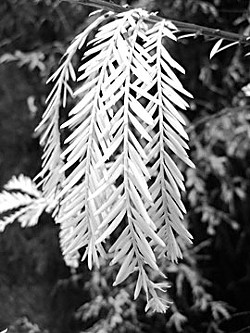[
{
"name": "Top Stories Video Pair",
"insertPoint": "7",
"component": "17087298",
"parentWrapperClass": "fdn-ads-inline-content-block",
"requiredCountToDisplay": "1"
}
]
Turns out that my weakness for rum balls is shared by the co-owner of Eureka Books. Scott and I found ourselves standing in front of what I think of as the "Temptation Display" in Ramones. "So what's the topic of your next Journal piece?" he asked. "Haven't a clue," I replied, "Any ideas?" "Albino redwoods." "You're putting me on," I said.
He wasn't. One of these mutant trees, the 30-foot tall "Christmas Tree," is located in the Women's Federation Grove just off the Avenue of the Giants in Humboldt Redwoods State Park. Another, the 20-foot tall Spirit Tree, sprouts from the base of a giant redwood in a grove three miles north of Redcrest. Only about 50 are known to exist. Several web sites refer to a tradition of the Pomo Indians using the albino trees in cleansing ceremonies, although I haven't been able to track down the original citation.
They don't grow much in comparison with their regular green cousins -- while the albino (latin albus = white) variety don't exceed 60 feet, many sequoia sempervirens grow to over 300 feet high. The record for the world's tallest living thing is currently held by the 379.1 foot "Hyperion" redwood discovered in Redwood National Park in 2006.
The albinos are mutant individuals that lack the capacity to manufacture chlorophyll, the green pigment found in most plants (the name comes from the Greek for "green" + "leaf"). Their leaves are creamy white and waxy. Chlorophyll absorbs sunlight in the blue and red portions of the spectrum and reflects green, which is why leaves are green--we see what the plant doesn't use. The blue and red absorbed light is converted, with the help of chlorophyll, into energy through photosynthesis, which in its most basic form goes like this:
Light energy + water + carbon dioxide = energy-rich carbohydrates (e.g. sucrose, glucose, starch) + oxygen
So if the albino redwoods lack chlorophyll, how do they survive? They're parasites. In an astonishing feat of survival, they get their nutrients by grafting their roots onto those of normal trees. Redwoods are unique in this -- while the odd mutation occurs, no other albino conifer reaches maturity.
Next: Mutant rum balls.
*Barry Evans ([email protected]) is a recovering civil engineer living in beautiful Old Town Eureka. His book *Everyday Wonders: Encounters with the Astonishing World Around Us led to a four-year stint as a science commentator on National Public Radio.
more from the author
-
Doubting Shakespeare, Part 2: Problems
- May 2, 2024
-
Doubting Shakespeare, Part 1: Stratfordians vs. anti-Stratfordians
- Apr 25, 2024
-
A Brief History of Dildos
- Apr 11, 2024
- More »
Latest in Field Notes
Readers also liked…
-
Trouble on the Line: The Reality Part 2
- Nov 3, 2022

































